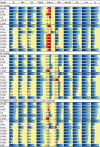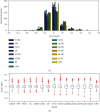Multiple Statistical Model Ensemble Predictions of Residual Chlorine in Drinking Water: Applications of Various Deep Learning and Machine Learning Algorithms
- PMID: 36213032
- PMCID: PMC9534677
- DOI: 10.1155/2022/7104752
Multiple Statistical Model Ensemble Predictions of Residual Chlorine in Drinking Water: Applications of Various Deep Learning and Machine Learning Algorithms
Abstract
Applicability of statistical models in predicting chlorine decay remains minimally explored. This study predicted residual chlorine using six deep learning and nine machine learning techniques. Suitability of multimodel ensembles (MMEs) including arithmetic mean of all the models (Ens1), average of the best three performing models (Ens2), and weighted mean of outputs from all the 15 models was investigated. A total of nine "goodness-of-fit" measures (such as distance correlation (r d) and Taylor skill score) were used to rank the models. The two best deep learning methods were the nonlinear autoregressive model with exogenous input (NARX) (r d = 0.51) and feedforward backpropagation (FFB) (r d = 0.61). The two best machine learning algorithms included random forests (RF) (r d = 0.64) and Gaussian process regression (GPR) (r d = 0.59). Eventually, Ens2 was obtained using RF, FFB, and GPR. Ens2 performed better than Ens1 and Ens3. The amount of variance explained by individual models and MMEs was over the ranges of 13-66% and 51-74%, respectively. Ens2 explained 74% of the total variance in observed residual chlorine. Remarkably, the appropriateness of the MMEs depends on the approach for combining model outputs, and the number of models considered. This study demonstrated the acceptability of statistical MMEs in predicting chlorine residual concentration in drinking water.
Copyright © 2022 Charles Onyutha.
Conflict of interest statement
The author declares no conflict of interest and no competing financial interests.
Figures






References
-
- World Health Organization. Water safety in distribution systems . Geneva-Switzerland: WHO Library Cataloguing-in-Publication Data; 2014. Available: (accessed: 7th March 2022)
-
- Onyutha C., Kwio-Tamale J. C. Modelling chlorine residuals in drinking water: a review. International journal of Environmental Science and Technology . 2022 doi: 10.1007/s13762-022-03924-3. - DOI
-
- World Health Organization. Principles and practices of drinking water chlorination: a guide to strengthening chlorination practices in small-to medium sized water supplies . New Delhi: World Health Organization, Regional Office for South-East Asia; 2017.
-
- Ishaq M. S., Afsheen Z., Khan A., Amjad Khan A. Disinfection Methods. In: Khan S. B., Akhtar K., editors. Photocatalysts-applications and attributes . Intech Open; 2018. pp. 3–19. - DOI
-
- Vuta L., Dumitran G. E. Some aspects regarding chlorine decay in water distribution networks . Cluj University Press; 2011. Available via http://aerapa.conference.ubbcluj.ro/2011/PDF/Vuta_Dumitran.pdf (accessed 12th September 2022)
MeSH terms
Substances
LinkOut - more resources
Full Text Sources
Medical

